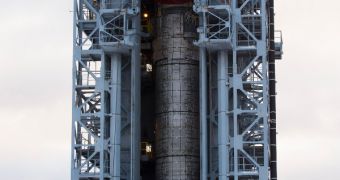Officials with the European Space Agency (ESA) announce that the three spacecraft making up the Swarm mission are currently undergoing final preparations at their Russian launch site. The satellites are scheduled to launch into Earth's orbit on November 22, 2013.
Swarm was originally scheduled to launch a couple of weeks ago, but a series of problems with its Rokot carrier rocket forced officials from the Plesetsk Cosmodrome, near Arkhangelsk, Russia, to postpone the flight. The delivery system is provided by the Eurockot company.
All three Swarm satellites are now encapsulated in their payload fairing, whose purpose is to protect them during the launch and ascent phases of the mission. Once in orbit, the fairing will be ejected, and a special adapter within will release the spacecraft in a certain pattern.
The Briz-KM upper stage on the Rokot rocket was installed in its Plesetsk launch tower this weekend, marking the last time ESA and Russian engineers will ever see them. The Swarm constellation spent the last two months undergoing a variety of tests, both in Europe and at its launch site.
According to the mission protocol, the payload fairing will be ejected from the tip of the rocket around three minutes after launch. A few minutes later, the second stage of the Rokot will be ignited. Once its fuel is spent, the Briz-KM will take Swarm spacecraft to their respective designated positions.
The vehicles will be injected into an Earth-centric orbit, at an altitude of 490 kilometers (305 miles), which is higher than the orbit occupied by the International Space Station (ISS). This is scheduled to occur about 90 minutes after launch.
Swarm satellites will spend the next four years in orbit, analyzing our planet's magnetic field and its interactions with charged particles released via solar winds. Additionally, the spacecraft will seek to determine how the magnetic field influences global climate change, if such a connection indeed exists.
Each vehicle in the constellation features five high-tech magnetic sensors. The capabilities of these devices will be augmented by the precise orbits ESA selected for its new mission, which is supposed to run for about 4 years.
The instruments on each Swarm satellite are the Vector Field Magnetometer (VFM), the Absolute Scalar Magnetometer (ASM), the Electric Field Instrument (EFI), the Accelerometer (ACC) and the Laser Range Reflector (LRR).

 14 DAY TRIAL //
14 DAY TRIAL //